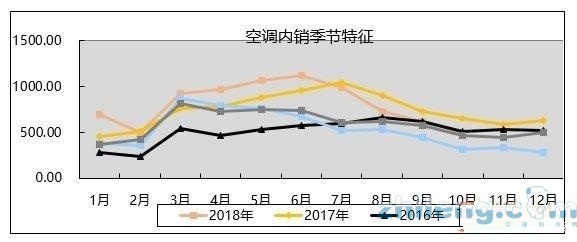Blog
Domestic sales decline, inventory pressure mounts, and the air conditioning industry faces the hidden worry of a price war.
Publish Time:
2018/12/06
The air conditioning market performed impressively in the first half of the year, but showed obvious fatigue in the second half. Ding Technology noted that the latest data from Industry Online shows that the terminal demand for air conditioners in 2019 was significantly lower than expected, with production and domestic sales showing a downward trend. The industry's overall inventory reduction effect was not significant, and there were significant concerns about price wars.
Due to the significant impact of weather factors, the development of the air conditioning industry in the first and second halves of the year differed greatly. In the first half of the year, according to data from Aowei Cloud Network, the industry was still developing steadily.
Aowei Cloud Network data shows that in the first half of 2018, the total retail sales of the air conditioning industry reached 114.7 billion yuan, with retail sales of 33.22 million units, representing year-on-year growth rates of 15.5% and 11.5%, respectively. Among them, online channel retail sales reached 35 billion yuan, with a growth rate as high as 42.1%, and retail sales reached 11.73 million units, a year-on-year increase of 30.6%. Offline channel retail sales reached 79.8 billion yuan, a year-on-year increase of 6.8%, and retail sales exceeded 21 million units, a year-on-year increase of 3.2%.
In the second half of the year, the air conditioning market took a sharp turn downwards, falling into negative growth. The "2018 China Home Appliance Industry Third Quarter Report" shows that the overall size of the Chinese home appliance market in the third quarter of 2018 was 182.1 billion yuan, a year-on-year decrease of 5.6%, of which the air conditioning market's retail sales fell by 8.7% year-on-year, while combined refrigerator and washing machine sales fell by 2.2%. In other words, among the main white goods products, the decline in air conditioners was the largest.
According to Industry Online monitoring, in October 2018, the production of household air conditioners reached 7.726 million units, a year-on-year decrease of 20.4%, and sales reached 7.5065 million units, a year-on-year decrease of 13.9%. Domestic sales were 4.9532 million units, a year-on-year decrease of 24.1%, and exports were 2.5533 million units, a year-on-year increase of 16.4%. The sluggish production and sales of complete machines put pressure on upstream compressor production, with the production of rotary compressors in October reaching 13.061 million units, a year-on-year decrease of 12.47%.
2017-2019 Cold Year October Air Conditioning Industry Domestic Sales Monthly Trend (Ten Thousand Units)

Weak production and sales put considerable pressure on the industry. Industry Online analysis believes that fatigue was already evident at the beginning of the 2019 new cold year, with terminal demand significantly lower than expected. From July onwards, some companies began to control production to digest inventory, but due to production inertia, the entire industry did not see a turning point until September, and the decline deepened further in October, especially with domestic sales falling below 5 million units, the lowest point in three years.
A greater pressure lies in the fact that due to weak demand, the inventory pressure in the air conditioning industry has not been relieved. Industry Online monitoring shows that at the end of September, the total inventory of household air conditioners had reached 42.04 million units. It should be noted that according to Zhongyikang data, the retail sales of air conditioners in China in 2017 reached 57.87 million units.
Under such great inventory pressure, air conditioning manufacturers can hardly increase their efforts to push goods to channels, and the feasible way to reduce inventory is likely to be only price wars. Recent frequent low-price promotions by air conditioning manufacturers also reflect that the previous inventory reduction efforts were not significant, and the subsequent market is not optimistic.
Ding Technology analysis believes that the air conditioning industry is greatly affected by external factors such as real estate and weather, and has strong cyclical characteristics. The rapid growth in the previous two years led some companies to expand their production capacity and increase their efforts in offline sales. However, as the industry enters a period of consolidation, blindly expanding production capacity and aggressively pushing goods to channels will create significant operational risks. At the same time, as it takes a period of time to consume high inventories, industry companies need to guard against the impact of price wars.
Key words:
Contact Information
Address: Room 1502, Building 2, No. 39, Shangyi Road, Minhang District, Shanghai
Phone:021-64130068
Mobile:18221910198(same as WeChat)
Fax:021-64135086
Email:asli@shinelong.com







